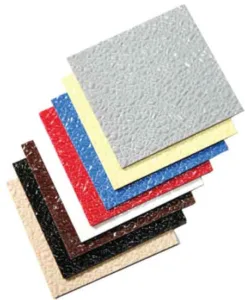Introduction
FRP boards, short for Fiber Reinforced Polymer boards, are integral components of modern engineering and construction. Understanding the composition and working of FRP boards is essential to fully grasp their significance in various industries. In this article, Unicomposite composite profiles delve into the scientific aspects of FRP, exploring what they are made of and how they function in different applications.

what is frp board
What is FRP?
FRP, or Fiber Reinforced Polymer, is a composite material comprising high-strength fibers embedded in a polymer matrix. This combination results in a material that exhibits exceptional strength, durability, and versatility. FRP materials are used in numerous industries, from civil engineering to automotive manufacturing.
Composition of FRP Boards
FRP boards consist of two main components: fibers and a polymer matrix. The fibers used in FRP can be glass, carbon, aramid, or other specialized materials. These fibers provide the material’s strength and stiffness. The polymer matrix, often epoxy or polyester resin, surrounds and binds the fibers together. Additives and fillers are introduced to enhance specific properties, such as fire resistance or UV stability.
Manufacturing Process
The manufacturing process of FRP boards involves meticulous layering of fibers and resin. The fibers are impregnated with the resin and arranged in a specific orientation to achieve the desired mechanical properties. The composite is then subjected to a curing process, which involves controlled temperature and pressure conditions. This curing process solidifies the resin, creating a robust and cohesive structure.
Working Principle of FRP Boards
FRP boards work on the principle of distributing external loads and stresses across the fibers and resin matrix. The fibers carry tensile and compressive loads, while the resin matrix transfers shear forces. This distribution of forces results in high load-bearing capacity, making FRP suitable for various structural applications. The bonding between the fibers and resin matrix contributes to the material’s overall strength.
Advantages of FRP Boards
FRP boards offer several advantages over traditional materials. Their high strength-to-weight ratio means they can bear heavy loads without excessive weight. Additionally, FRP is highly resistant to corrosion, making it suitable for harsh environments. Design flexibility is another key advantage, allowing engineers to tailor the material to specific project requirements.
Applications
The applications of FRP boards are diverse. In the construction industry, they are used in bridge decks, columns, and reinforcing concrete structures. The automotive sector employs FRP for bumpers, panels, and chassis components. Aerospace applications benefit from FRP’s lightweight and high-strength properties.
Comparison with Other Materials
Compared to traditional materials like steel and wood, FRP offers distinct advantages. While steel is strong, it’s susceptible to corrosion, whereas wood lacks the same strength-to-weight ratio as FRP. Additionally, FRP’s lower environmental impact is a consideration in today’s sustainability-focused world.
Challenges and Limitations
Despite its benefits, FRP also faces challenges. Cost implications can be significant, especially for large-scale projects. UV degradation is a concern, necessitating protective coatings in outdoor applications. Standardized testing methods are still evolving, making quality control a priority.
Innovations and Future Prospects
Ongoing research aims to enhance FRP’s performance even further. Researchers are exploring new fiber combinations, resin formulations, and manufacturing techniques. The potential for improving fire resistance and increasing material efficiency is a focus of innovation.
Maintenance and Durability
FRP boards exhibit impressive durability, with a lifespan that can surpass traditional materials. Regular inspections and appropriate maintenance are key to ensuring their long-term performance. Repair techniques, such as patching and resin infusion, can address localized damage.
Real-world Examples
One notable example of FRP application is in bridge construction. FRP-reinforced concrete elements increase the structure’s longevity and load-bearing capacity. In extreme conditions, such as earthquakes, FRP can provide enhanced structural resilience.
Safety Considerations
While FRP is generally fire-resistant, specific formulations can improve its performance in high-temperature situations. Adherence to safety regulations is vital when using FRP in applications where fire safety is a concern.
Conclusion
In conclusion, FRP boards are a remarkable example of innovative material engineering. Their composition of high-strength fibers and polymer matrix leads to exceptional mechanical properties. FRP’s versatility spans across industries, offering solutions to challenges faced by traditional materials.
FAQs
- What are the main types of fibers used in FRP? FRP can be reinforced with fibers such as glass, carbon, and aramid, each offering unique characteristics.
- Can FRP boards replace traditional materials entirely? While FRP offers numerous benefits, it may not entirely replace traditional materials but can complement them in specific applications.
- Are FRP boards suitable for underwater applications? Yes, FRP’s corrosion resistance makes it suitable for underwater structures like marine platforms and pipelines.
- How does the cost of FRP compare to other materials? FRP can be more expensive than traditional materials upfront, but its long-term durability can offset maintenance costs.
- What measures can be taken to enhance the fire resistance of FRP boards? Fire-resistant additives and coatings can improve FRP’s performance in high-temperature situations.
 info@unicomposite.com
info@unicomposite.com


























